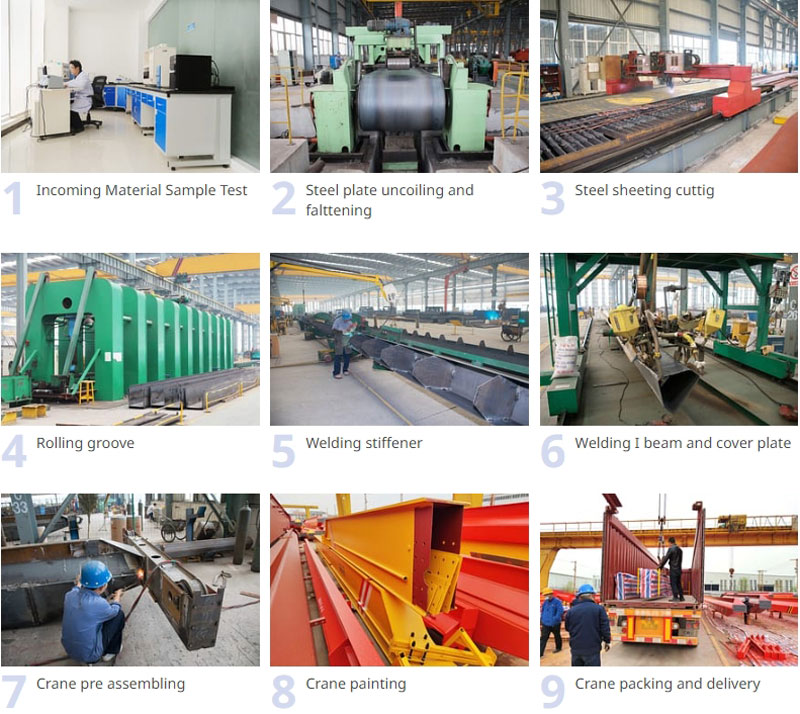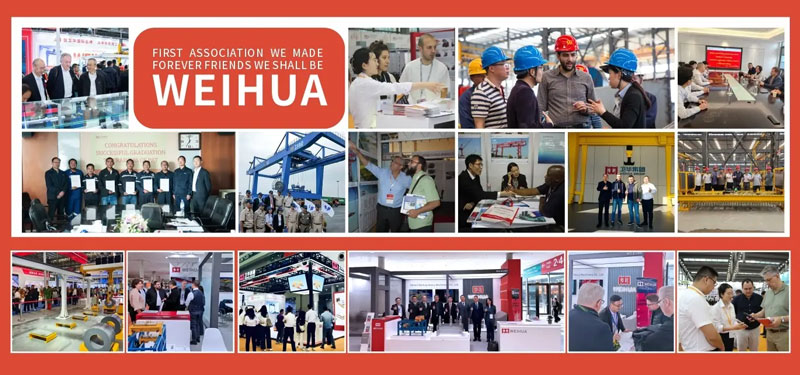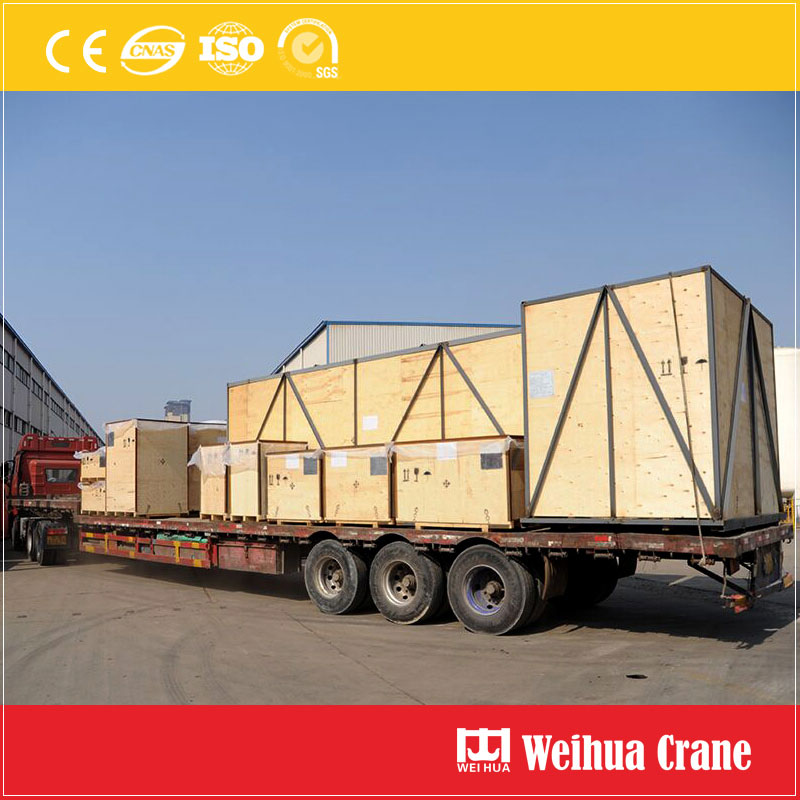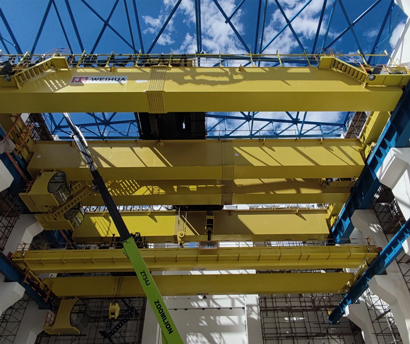Un puente grúa es un equipo de manipulación de materiales de alta resistencia diseñado para levantar, mover, y colocar cargas grandes o pesadas horizontalmente a lo largo de un tramo fijo.

Un puente grúa es un equipo de manipulación de materiales de alta resistencia diseñado para levantar, mover, y colocar cargas grandes o pesadas horizontalmente a lo largo de un tramo fijo. Suspendido o montado en pistas elevadas (normalmente a lo largo de una instalación), Consiste en una estructura de puente que recorre estas pistas., con un sistema de polipasto o carro que se mueve perpendicular al puente, lo que permite una precisión, movimiento de carga multidireccional.
Ampliamente utilizado en entornos industriales., Los puentes grúa agilizan las operaciones, reducir el trabajo manual, y mejorar la seguridad al manipular pesos desde unas pocas toneladas hasta cientos de toneladas. Son personalizables para adaptarse a dimensiones específicas del espacio de trabajo., requisitos de carga, y condiciones ambientales, haciéndolos indispensables en la fabricación, logística, e industrias pesadas.

Los puentes grúa están diseñados para brindar confiabilidad, eficiencia, y seguridad. Estas son sus características principales.:


La elección entre puentes grúa monorraíl y birraíl depende de sus necesidades de carga, espacio de trabajo, y presupuesto. Aquí hay un desglose:
|
Característica
|
Puente grúa aéreo de una sola viga
|
Puente grúa aéreo de doble viga
|
|
Estructura
|
Una viga principal (haz) sosteniendo el polipasto/carro.
|
Dos vigas paralelas con el polipasto/carro entre ellas.
|
|
Capacidad de carga
|
Arriba a 20 montones (estándar); 50 montones (modelos de servicio pesado).
|
20 toneladas y más (comúnmente entre 50 y 500+ toneladas).
|
|
Longitud del tramo
|
Ideal para luces de hasta 30 medidores.
|
Adecuado para tramos más largos (arriba a 50+ medidores).
|
|
Altura de elevación
|
Moderado (limitado por la resistencia de una sola viga).
|
Mayores alturas de elevación (espacio adicional gracias a las vigas dobles).
|
|
Costo
|
Más asequible (diseño más simple, menor uso de materiales).
|
Mayor costo inicial (construcción más robusta, componentes más grandes).
|
|
Mejor para
|
Cargas ligeras a medias; instalaciones pequeñas y medianas (P.EJ., talleres, almacenes).
|
Cargas pesadas, grandes luces, o entornos hostiles (P.EJ., fábricas de acero, astilleros).
|

A continuación se muestra una tabla de parámetros generales para los modelos comunes de puentes grúa.. Las especificaciones personalizadas están disponibles según sus necesidades.:
|
Tipo de modelo
|
Capacidad máxima de elevación
|
Longitud del tramo
|
Altura de elevación
|
Clase trabajadora (ISO/FEM)*
|
Fuente de alimentación
|
Velocidad de elevación
|
|
Viga única (Estándar)
|
1–20 toneladas
|
5–30 metros
|
3–12 metros
|
A3-A5
|
380V/3F/50Hz (costumbre)
|
0.5–10 m/l
|
|
Viga única (Servicio pesado)
|
20–50 toneladas
|
10–25 metros
|
5–15 metros
|
A5-A6
|
380V/3F/50Hz (costumbre)
|
0.3–8 m/yo
|
|
Doble viga (Estándar)
|
20–100 toneladas
|
10–40 metros
|
6–20 metros
|
A6–A7
|
380V/3F/50Hz (costumbre)
|
0.2–6 m/yo
|
|
Doble viga (Ultrapesado)
|
100–500+ toneladas
|
15–50+ metros
|
8–30 metros
|
A7–A8
|
Costumbre (diésel/eléctrico)
|
0.1–4 m/yo
|
Clase trabajadora: Indica ciclo de trabajo (con qué frecuencia la grúa opera bajo carga). clases superiores (A7–A8) traje continuo, entornos de uso intensivo.

Las grúas puente son versátiles en todos los sectores que requieren manipulación de materiales pesados.. Las aplicaciones clave incluyen:


Siga estos pasos para seleccionar el puente grúa perfecto para sus necesidades:
Q1: ¿Con qué frecuencia se debe inspeccionar un puente grúa??
A: Controles visuales diarios (para usar, fugas, o piezas sueltas) y las inspecciones profesionales anuales son obligatorias. Grúas de uso pesado (A7–A8) puede requerir inspecciones trimestrales.
Q2: ¿Se pueden automatizar los puentes grúa??
A: Sí. Los modelos modernos pueden integrarse con sistemas IoT para el seguimiento automatizado de la carga, movimientos programados, y operación remota: ideal para tareas repetitivas.
Q3: ¿Cuál es la vida útil de un puente grúa??
A: Con un mantenimiento adecuado, Las grúas monorraíl duran entre 15 y 20 años.; Las grúas de dos vigas pueden funcionar durante 25 a 30 años o más..
Q4: ¿Cómo se instala un puente grúa??
A: La instalación implica montar pistas en columnas de construcción o estructuras de soporte., posicionando el puente, e integración del polipasto/carro. Se recomienda la instalación profesional por seguridad..
Q5: ¿Cuál es la diferencia entre un puente grúa y una grúa pórtico??
A: Puentes grúa circulan por pistas elevadas (adjunto a un edificio), mientras grúas de pórtico tienen patas apoyadas en el suelo, lo que hace que los pórticos sean mejores para espacios abiertos o al aire libre.
Listo para mejorar su eficiencia en el manejo de materiales? Contáctenos para obtener una solución de puente grúa personalizada adaptada a su industria y flujo de trabajo.
Compartir con PDF: Descargar


Valoramos sus comentarios! Complete el formulario a continuación para que podamos adaptar nuestros servicios a sus necesidades específicas..

Las operaciones de fundición exigen resistencia, equipo de elevación confiable que puede soportar condiciones extremas……
Descubre más →
El 2 La grúa puente de toneladas es un equipo de elevación versátil y confiable diseñado para satisfacer……
Descubre más →
El 50 Transporte aéreo eléctrico de doble viga MT (Eot) La grúa es un material resistente……
Descubre más →

Haga clic en el botón para obtener información del producto y cotizaciones en WhatsApp.
Obtener una cotización
Últimos comentarios